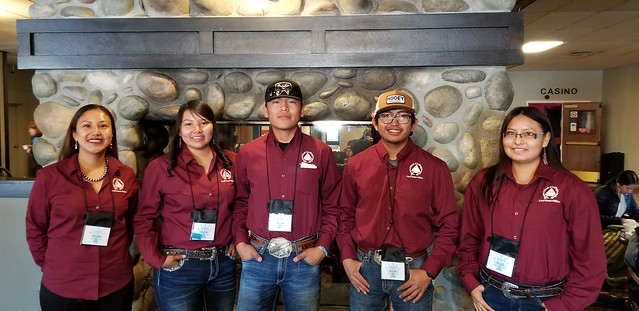
Food sovereignty – the ability to create a self-sufficient food system – is at the heart of the opportunities and challenges facing the Navajo Nation. This spring, Diné College students Tyler Begay, Korrie Johnnie, and Orean Roy were recognized for their exploration of this topic during the American Indian Higher Education Consortium Student Conference in Billings, Montana.
Their paper “Reestablishing the Navajo Agricultural Economy and the Importance of Traditional Values” took first place as part of a USDA-hosted contest to encourage discussion on tribal issues that can be addressed through USDA programs. “These student reports provide an authentic perspective of active farmers and producers on tribal lands, which are informed by USDA-sponsored research at 1994 land-grant Institutions,” noted Lawrence Shorty, USDA 1994 Program Director.
The students highlighted the Tolani Lake Water Project, which succeeded by using traditional Navajo principles. In 2001, the Navajo Nation Tolani Lake Chapter partnered with USDA National Resources Conservation Service (NRCS) and other government and community entities to address rancher challenges. “Water is a very big issue on the reservation, due to the lack of permanent water sources like wells, springs, or windmills,” said Tyler Begay. He noted how the community developed a rotational grazing system using water tanks, a system that allowed livestock producers to practice land and water conservation simultaneously. What was once a pilot project with one group of ranchers, 7,000 acres, and 3 water tanks, has since expanded to 29 tanks that serve seven groups and 60,000 acres across the Navajo Nation.
The students emphasized the value of tribal traditions and customs in agriculture. Central to the success of the Tolani Lake Water Project is the Navajo Kinship model of K’é. “[K’é] is a system in which each Diné [Navajo] individual observes the interconnected relationship they have with all living systems, and the responsibility an individual has to preserve natural resources through conservation practices,” said Korrie Johnnie. The Tolani Lake community developed a conservation plan as a group, treating all participants as equals, with equal respect. “The sustainability of the project stems from the community members taking pride in ownership of the project by building the water system themselves,” added Orean Roy.
All three students are interns at the Diné College Land Grant Office in Tsaile, Arizona. The office provides technical service and outreach to Navajo ranchers, farmers, families and youth. Diné College is one of 35 federally recognized tribal colleges and universities that are designated as land-grant institutions through the Equity in Educational Land-Grant Status Act of 1994. For reservation communities, these 1994 land-grant institutions help improve the lives and career opportunities for Native students and the communities at large.
The USDA 1994 Tribal Land-Grant Colleges and Universities Program ensures that these institutions, their students, and the Native American communities they serve have equitable access to USDA programs and services. Additionally, the program works to attract students to USDA and agriculture-related careers.
